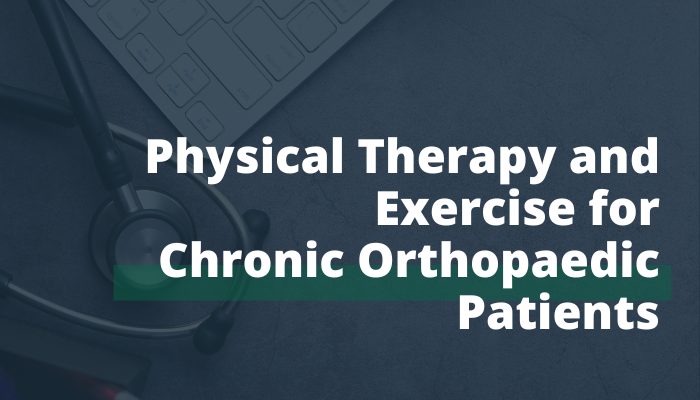8 Effective Strategies For Primary Care Providers In Managing Chronic Orthopaedic Conditions
10 Mins Read
Published on: 11 April 2023
Last Updated on: 21 February 2025

toc impalement
In an era where chronic orthopedic conditions continue to rise, primary care doctors must equip themselves with effective strategies to manage these ailments.
As the gatekeepers to the healthcare system, primary care doctors often encounter patients with chronic orthopedic conditions. This can significantly impact their quality of life.
Managing these conditions poses multifaceted challenges. It involves the appropriate diagnosis and treatment.
Primary care doctors must comprehensively understand the patient’s needs and concerns.
Let’s uncover the nuances of chronic orthopedic conditions. This will also provide primary care doctors in Portland with the strategies and knowledge required to make a tangible difference in their patient’s lives.
What are Primary Care Doctors?
Primary care doctors are crucial in the healthcare system as they serve as patients’ first point of contact.
By fostering long-term patient relationships, primary care physicians can better understand individual needs, ensuring effective coordination and continuity of care.
Primary care physicians need to foster long-term patient relationships. This is to understand individual needs better. Doing this can ensure effective coordination and continuity of care.
Their holistic approach to healthcare improves patient outcomes and reduces healthcare costs by preventing unnecessary hospitalizations and specialist visits.
Their holistic approach to healthcare improves patient outcomes. This can also reduce healthcare costs by preventing unnecessary hospitalizations and specialist visits.
This resource presents various evidence-based strategies tailored to primary care doctors. It is designed to empower them with the tools to manage chronic orthopedic conditions confidently and effectively.
Here Are The Eight Best Strategies For Primary Care Providers In Managing Chronic Orthopaedic Conditions
Let’s discuss the strategies one by one.
1. Optimising Early Diagnosis and Intervention
Early diagnosis and intervention play a crucial role in managing chronic orthopedic conditions.
By recognizing the signs and symptoms early on, primary care doctors can effectively collaborate with specialists to improve patient outcomes.
Recognizing and responding to early signs and symptoms.
Primary care providers should familiarize themselves with common signs and symptoms of orthopedic conditions. This is to ensure effective early diagnosis.
Effective referrals and collaborations.
Collaboration and communication between healthcare providers are vital in the early diagnosis and intervention of orthopedic conditions.
Patients should actively participate in their care. They can do this by seeking professionals and fostering strong relationships with their healthcare team.
How to find a primary care doctor with orthopedic expertise:
- Seek referrals: Ask family and friends for recommendations of primary care doctors with expertise in orthopedic care.
- Research online: Use online directories and review sites to identify primary care physicians. Ensure that they have positive reviews and a focus on orthopedic issues.
- Verify credentials: Confirm that the primary care doctor is board-certified and has specialized training in orthopedics.
- Schedule an initial consultation: During a preliminary meeting, assess the doctor’s communication style, availability, and overall approach to patient care.
Importance of working closely with specialists:
To maximize the benefits of early diagnosis and intervention, primary care doctors and orthopedic specialists should maintain open lines of communication. They must collaborate closely on patient care.
This collaboration may include the following:
- Sharing medical records and test results.
- Coordinating care between multiple specialists, such as physical therapists or orthopedic surgeons. By doing this, you can create a comprehensive treatment plan.
- Regularly updating one another on patient progress. This is to monitor the effectiveness of treatments and adjust as needed.
2. Empowering Patients Through Education
It is essential to prioritize patient education to ensure that individuals understand their:
- orthopedic conditions
- treatment options
- self-management strategies
Find out valuable information to enhance patient education.
Understanding orthopedic conditions.
Provide patients with clear information about their condition by presenting a detailed diagnosis explanation using medical terms and layman’s language.
Primary care providers can also utilize visual aids. Examples are anatomical models, charts, or diagrams. This is to help illustrate the affected area and its function.
Discuss the possible long-term consequences of the orthopedic condition if left untreated or improperly managed.
Explain how the condition might affect a patient’s daily life, mobility, and overall well-being.
Exploring treatment options.
Provide a comprehensive list of non-invasive (conservative) and invasive (surgical) treatment options for the specific orthopedic condition.
Explain the benefits and risks associated with each treatment, recovery time, and potential outcomes.
To communicate various options, you must encourage patients to openly communicate their concerns and preferences with their primary care doctor or general practitioner.
Patients can prepare a list of questions or concerns to discuss with their primary care physician during appointments.
You must guide patients on how to find a primary care doctor if they don’t already have one. You can recommend resources such as online directories and local health networks or ask for referrals.
3. Implementing a Multidisciplinary Care Approach
Multidisciplinary care involves a team of healthcare professionals from different specialties. They work together to address the various needs of a patient.
This approach aims to provide comprehensive and coordinated care, ensuring patients receive the right treatment at the right time.
Collaborating with other healthcare professionals.
A key aspect of multidisciplinary care is the collaboration between the primary care doctor and other healthcare providers. Examples are orthopedic specialists, physical therapists, and mental health providers.
This collaboration involves orthopedic specialists to address musculoskeletal issues and suggest appropriate interventions, including surgery, medication, or assistive devices.
Working with physical therapists to develop and implement a rehabilitation program that helps patients regain mobility, strength, and function.
Coordinating and monitoring care.
A primary care doctor is crucial in coordinating and monitoring the patient’s care.
This involves:
- Ensuring regular follow-ups and progress monitoring to assess the patient’s response to treatment and make necessary adjustments.
- Adjusting treatment plans as needed. This is based on changes in the patient’s condition or response to therapy.
- In facilitating communication between the patient and other healthcare providers, They must ensure that all team members are informed about the patient’s progress and any changes.
4. Integrating Physical Therapy and Exercise

Physical therapy and exercise play a crucial role in the recovery process for many patients, particularly those with orthopedic issues.
A well-designed exercise program can aid in improving mobility, strength, and flexibility while reducing pain and inflammation.
Primary care doctors, general practitioners, and physical therapists collaborate to prescribe appropriate exercise programs tailored to each patient’s needs.
Prescribing appropriate programs.
A primary care doctor will assess a patient’s health, physical condition, and medical history. This is to determine the most suitable exercise program.
This personalized approach ensures that the exercise regimen meets the individual’s needs and abilities, maximizing its effectiveness.
Working with physical therapists for specialized guidance.
A primary care physician may collaborate with a physical therapist to develop a more specialized exercise program for complex patient needs.
Physical therapists have expert knowledge in designing rehabilitation programs. Their guidance can help ensure the prescribed exercises are safe, effective, and tailored to the patient’s requirements.
Improving mobility, strength, and flexibility.
Regular exercise can significantly impact a patient’s overall physical well-being. Specifically, targeted exercises can help orthopedic patients regain lost mobility, strengthen weakened muscles, and improve flexibility in stiff joints.
For example, a patient recovering from knee surgery may benefit from strengthening exercises, such as squats, leg presses, and stretching routines to improve joint flexibility.
Reducing pain and inflammation.
Exercise is often prescribed as a component of pain management for orthopedic patients. Physical activity can increase blood flow, promoting healing in injured tissues and helping to reduce inflammation.
Additionally, exercise stimulates the release of endorphins, which are natural painkillers.
As a result, a patient suffering from chronic lower back pain may experience relief through a combination of core strengthening exercises and gentle stretches.
5. Developing a Sustainable Weight Management Plan
Weight management plays a crucial role in the management of chronic orthopedic conditions.
As a primary care provider, helping patients achieve and maintain a healthy weight can significantly improve their overall well-being. This can reduce the risk of complications associated with excess weight.
Synergizing nutrition and exercise.
Primary care doctors should emphasize the importance of proper nutrition and exercise in maintaining a healthy weight.
Encourage patients to set realistic weight loss goals and provide resources or referrals to registered dietitians, nutritionists, or weight management programs.
Regular follow-up appointments can help track progress and adjust recommendations as needed.
Educate patients about the impact of dietary choices on bone and joint health. Include the importance of adequate calcium, vitamin D, and anti-inflammatory foods.
A general physician can guide specific dietary changes tailored to each patient’s needs.
Incorporating exercise into weight management plans.
Develop individualized exercise plans for patients considering their orthopedic condition, fitness level, and preferences.
Encourage low-impact activities such as swimming, cycling, or walking, and consider referring patients to a physical therapist for personalized guidance.
The impact of excess weight on orthopedic conditions can worsen the symptoms and increase the risk of complications.
6. Maximizing Mobility Through Assistive Devices and Equipment
Managing chronic orthopedic conditions in patients effectively is crucial. Assistive devices and adaptive equipment can greatly improve patients’ quality of life and help them maintain their independence.
Identifying appropriate devices.
A primary care doctor is vital in recommending suitable assistive devices and adaptive equipment. This involves:
1. Recommending braces, splints, and orthotics:
- Assessing patients’ needs based on their condition and mobility.
- Collaborating with specialists (e.g., orthoptists, physiotherapists) to determine the most appropriate device.
- Ensuring proper fit and comfort for the patient.
2. Evaluating the need for canes, walkers, and wheelchairs:
The most appropriate mobility aid depends on the patient’s balance, strength, and endurance. Collaborating with occupational therapists for home assessments to determine the best options for the patient’s living environment.
Considering factors such as ease of use, durability, and cost when recommending a specific device.
Improving function and independence.
A primary care physician should focus on helping patients maximize the benefits of their assistive devices and adaptive equipment. This includes:
1. Ensuring patients understand the proper use of devices:
- Providing clear instructions on how to use and care for the device.
- Encouraging patients to ask questions and express concerns.
- Referring patients to additional resources, such as instructional videos or support groups. This is to help them feel confident in using their equipment.
2. Monitoring patient progress with assistive equipment:
- Scheduling regular follow-ups to assess the patient’s comfort and satisfaction with their device.
- Promptly addresses any issues that may arise, such as malfunctions or discomfort.
- Collaborating with other healthcare professionals to modify treatment plans if necessary.
7. Prioritizing Mental Health Support
Chronic orthopedic conditions can have significant physical and emotional consequences for patients.
As a primary care provider, it is essential to address both aspects to deliver comprehensive care.
Addressing psychological aspects.
Understand that chronic pain, limited mobility, and other challenges associated with orthopedic conditions can lead to anxiety, depression, and other mental health concerns.
Maintain a non-judgmental and empathetic approach while discussing these concerns with your patients.
1. Discussing mood, self-esteem, and overall well-being with patients:
- Regularly assess the emotional well-being of your patients by asking questions about their mood, self-esteem, and overall satisfaction with life.
- Encourage patients to share their feelings, experiences, and concerns about their condition and its impact on their daily lives.
- Address any emotional distress or mental health symptoms that may arise, and provide appropriate guidance and support.
2. Incorporating mental health support into the care plan:
- Collaborate with mental health professionals and other healthcare team members. Do this to develop a care plan that addresses the patient’s physical and emotional condition.
- Include mental health interventions. Examples are cognitive-behavioral therapy, mindfulness techniques, or support groups as part of the care plan. This is to help patients cope with their condition and improve their overall quality of life.
8. Proactively Implementing Preventive Measures
As a general practitioner, your role in managing chronic orthopedic conditions extends beyond diagnosis and treatment.
Preventive measures are essential in reducing the risk of developing these conditions or worsening existing ones.
Educating patients on minimizing risks for developing or worsening orthopedic conditions.
Take the time to discuss with your patients the common risk factors for orthopedic conditions. Examples are obesity, poor posture, or inadequate physical activity.
Encourage lifestyle changes that promote a healthy weight, good posture, and regular exercise to keep joints and muscles strong and flexible.
Explaining the importance of proper body mechanics.
Teach patients to maintain proper body mechanics during everyday activities, such as lifting, carrying, or sitting for extended periods.
This can help reduce the strain on their joints and muscles, minimizing the risk of injury and chronic conditions.
For example, when lifting heavy objects, patients should bend at the knees and keep the back straight to protect the spine.
Improving workplace ergonomics.
Recommending ergonomic adjustments to reduce strain on joints and muscles
Advise patients on setting up their work to minimize the risk of developing or exacerbating orthopedic conditions.
This includes adjusting their chair, desk, and computer monitor to ensure proper alignment and support, using a footrest if necessary, and taking regular breaks to stand and stretch.
Conclusion
Effectively managing chronic orthopedic conditions is critical to primary care providers’ work, including general practitioners, physicians, and primary care doctors.
Implementing strategies and technology can significantly improve patient outcomes and overall quality of life.
Primary care providers can ensure better care for individuals with chronic orthopedic conditions by taking a comprehensive, patient-centered approach.
This will contribute to their long-term health and well-being.
FAQs
1. What are the 8 effective strategies for primary care providers in managing chronic orthopedic conditions?
Answer: The 8 effective strategies for primary care providers in managing chronic orthopedic conditions include patient education, physical therapy, non-pharmacological interventions, pharmacological interventions, interventional procedures, referral to specialists, coordinated care, and patient engagement.
2. What non-pharmacological interventions are effective in managing chronic orthopedic conditions?
Answer: Non-pharmacological interventions that effectively manage chronic orthopedic conditions include exercise, weight management, heat or cold therapy, acupuncture, manual therapy, and cognitive-behavioral therapy.
3. What pharmacological interventions are commonly used in managing chronic orthopedic conditions?
Answer: Pharmacological interventions commonly used in managing chronic orthopedic conditions include non-steroidal anti-inflammatory drugs (NSAIDs), acetaminophen, opioids, antidepressants, and anticonvulsants.
4. What interventional procedures are effective in managing chronic orthopedic conditions?
Answer: Interventional procedures that effectively manage chronic orthopedic conditions include steroid injections, nerve blocks, radiofrequency ablation, and joint replacement surgery.
5. How can coordinated care and patient engagement improve the management of chronic orthopedic conditions?
Answer: Coordinated care and patient engagement can improve the management of chronic orthopedic conditions. This ensures that patients receive comprehensive and consistent care from all providers involved in their treatment. It promotes better communication and collaboration among providers and empowers patients to manage their condition through education, goal-setting, and self-management strategies.
Read Also:


















Comments Are Closed For This Article